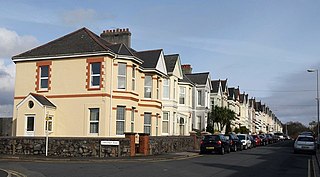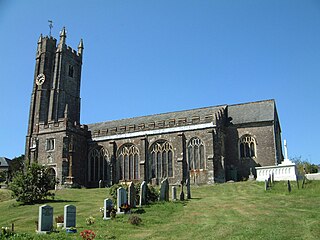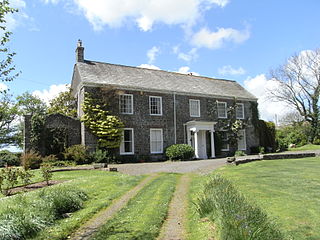Related Research Articles

Peverell is a neighbourhood of Plymouth in the English county of Devon. The 2001 Census estimated the population as 6,455, increasing dramatically to 13,553 at the 2011 census.

Knowstone is a village and civil parish situated in the North Devon district of Devon, England, halfway between the Mid Devon town of Tiverton, Devon and the North Devon town of South Molton. The hamlet of East Knowstone lies due east of the village. Knowstone was the birthplace of Admiral Sir John Berry (1635–1691), second son of Rev. Daniel Berry (1609–1654), vicar of Knowstone cum Molland. An elaborate mural monument erected by Sir John in 1684 to the memory of his parents survives in Molland Church.

Harberton is a village, civil parish and former manor 3 miles south west of Totnes, in the South Hams District of Devon, England. The parish includes the village of Harbertonford situated on the main A381 road. In the 2001 census the parish had a population of 1,285. The village is a major part of the electoral ward of Avon and Harbourne. At the 2011 census the ward population was 2,217.

Huish is a small village, civil parish and former manor in the Torridge district of Devon, England. The eastern boundary of the parish is formed by the River Torridge and the western by the Rivers Mere and Little Mere, and it is surrounded, clockwise from the north, by the parishes of Merton, Dolton, Meeth and Petrockstowe. In 2001 the population of the parish was 49, down from 76 in 1901.

From AD 1066, the feudal barony of Barnstaple was a large feudal barony with its caput at the town of Barnstaple in north Devon, England. It was one of eight feudal baronies in Devonshire which existed in the Middle Ages. In 1236 it comprised 56 knight's fees or individual member manors. The feudal service owed for half the barony in 1274 was the provision to the royal army of two knights or four sergeants for forty days per annum, later commuted to scutage.

Sydenham House in the parish of Marystow in Devon, England, is a seventeenth-century manor house. The Grade I listed building is situated about thirteen miles south-west of Okehampton, on a 1,200 acres (490 ha) estate. It was built by Sir Thomas Wise (d.1629) between 1600 and 1612, incorporating an older structure. It was partially destroyed by fire in 2012. The gardens are Grade II listed in the National Register of Historic Parks and Gardens.

Collaton St Mary is a village, parish and former manor in Devon, England, situated about 2 miles (3 km) west of the town of Paignton. The village is bisected by the A385 Paignton to Totnes road. The parish is now administered within the unitary authority of Torbay, Devon.

The feudal barony of Okehampton was a very large feudal barony, the largest mediaeval fiefdom in the county of Devon, England, whose caput was Okehampton Castle and manor. It was one of eight feudal baronies in Devonshire which existed during the mediaeval era.
According to Sanders (1960) there were eight certain or probable English feudal baronies in Devonshire:
Walter I de Claville was an Anglo-Norman magnate and one of the 52 Devon Domesday Book tenants-in-chief of King William the Conqueror. He also held lands in Dorset. His Devonshire estates later formed part of the feudal barony of Gloucester.

The Domesday Book of 1086 lists in the following order the tenants-in-chief in Devonshire of King William the Conqueror:

The feudal barony of Plympton was a large feudal barony in the county of Devon, England, whose caput was Plympton Castle and manor, Plympton. It was one of eight feudal baronies in Devonshire which existed during the medieval era. It included the so-called Honour of Christchurch in Hampshire, which was not however technically a barony. The de Redvers family, first holders of the barony, were also Lords of the Isle of Wight, which lordship was not inherited by the Courtenays, as was the barony of Plympton, as it had been sold to the king by the last in the line Isabel de Redvers, 8th Countess of Devon (1237–1293).

Thuborough in the parish of Sutcombe, Devon, England, is an historic estate, formerly a seat of a branch of the Prideaux family, also seated at Orcharton, Modbury; Adeston, Holbeton; Soldon, Holsworthy; Netherton, Farway; Ashburton; Nutwell, Woodbury; Ford Abbey, Thorncombe, all in Devon and at Prideaux Place, Padstow and Prideaux Castle, Luxulyan, in Cornwall. The present mansion house, comprising "Thuborough House" and "Thuborough Barton", the north-east block, is a grade II listed building.
Robert of Aumale was one of the Devon Domesday Book tenants-in-chief of King William the Conqueror (1066–1087). His lands, comprising 17 entries in the Domesday Book of 1086, later formed part of the very large Feudal barony of Plympton, whose later barons were the Courtenay family, Earls of Devon.

The feudal barony of Great Torrington whose caput was Great Torrington Castle in Devonshire, was one of eight feudal baronies in Devonshire which existed during the mediaeval era.
Walter FitzOther son of Otho Gherardini. He was a feudal baron of Eton in Buckinghamshire and was Constable of Windsor Castle in Berkshire, a principal royal residence of King William the Conqueror, and was a tenant-in-chief of that king of 21 manors in the counties of Berkshire, Buckinghamshire, Surrey, Hampshire and Middlesex, as well as holding a further 17 manors as a mesne tenant in the same counties.

Widworthy is a village, parish and former manor in Devon, England. The village is 3 1/2 miles east of Honiton and the parish is surrounded clockwise from the north by the parishes of Stockland, Dalwood, Shute, Colyton, Northleigh, and Offwell. The parish church is dedicated to St Cuthbert. Near the church is Widworthy Barton, the former manor house, which is largely unaltered from its early 17th century form. Widworthy Court is a mansion within the parish built in 1830 by Sir Edward Marwood Elton to the design of G.S. Repton.

South Milton is a village and civil parish in Devon, England, situated on the south coast about 2 miles south-west of Kingsbridge. The civil parish includes the hamlets of Sutton, south of the village, and Upton, north of the village.
The manor of Broad Hempston was an historic manor situated in Devon, England, about 4 miles north of Totnes. The present village known as Broadhempston was the chief settlement within the manor and remains the location of the ancient parish church of St Peter and St Paul.

Spridleston is an historic manor in the parish of Brixton in Devon, England, long a seat of a branch of the prominent and widespread Fortescue family. The ancient manor house does not survive, but it is believed to have occupied the site of the present Spriddlestone Barton, a small Georgian stuccoed house a few hundred yards from the larger Spriddlestone House, also a Georgian stuccoed house, both centred on the hamlet of Spriddlestone and near Higher Spriddlestone Farm.
References
- ↑ 8 according to Sanders, I.J. English Baronies: A Study of their Origin and Descent 1086-1327, Oxford, 1960; 12 according to Pole, Sir William (d.1635), Collections Towards a Description of the County of Devon, Sir John-William de la Pole (ed.), London, 1791, Book I, pp.1-33
- ↑ Thorn, Caroline & Frank, (eds.) Domesday Book, (Morris, John, gen.ed.) Vol. 9, Devon, Parts 1 & 2, Phillimore Press, Chichester, 1985, Part 2 (notes), 17,73